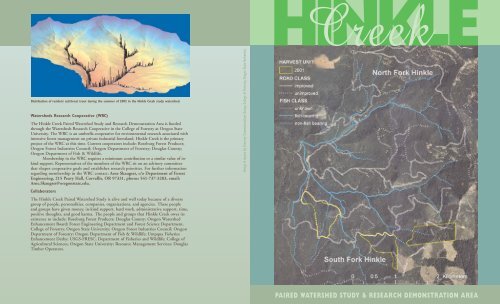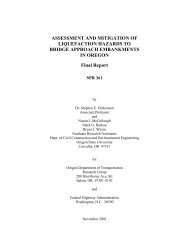Hinkle Creek Paired Watershed Study and ... - State of Oregon
Hinkle Creek Paired Watershed Study and ... - State of Oregon
Hinkle Creek Paired Watershed Study and ... - State of Oregon
Create successful ePaper yourself
Turn your PDF publications into a flip-book with our unique Google optimized e-Paper software.
Distribution <strong>of</strong> resident cutthroat trout during the summer <strong>of</strong> 2002 in the <strong>Hinkle</strong> <strong>Creek</strong> study watershed.<br />
<strong>Watershed</strong>s Research Cooperative (WRC)<br />
The <strong>Hinkle</strong> <strong>Creek</strong> <strong>Paired</strong> <strong>Watershed</strong> <strong>Study</strong> <strong>and</strong> Research Demonstration Area is funded<br />
through the <strong>Watershed</strong>s Research Cooperative in the College <strong>of</strong> Forestry at <strong>Oregon</strong> <strong>State</strong><br />
University. The WRC is an umbrella cooperative for environmental research associated with<br />
intensive forest management on private industrial forestl<strong>and</strong>. <strong>Hinkle</strong> <strong>Creek</strong> is the primary<br />
project <strong>of</strong> the WRC at this time. Current cooperators include: Roseburg Forest Products;<br />
<strong>Oregon</strong> Forest Industries Council; <strong>Oregon</strong> Department <strong>of</strong> Forestry; Douglas County;<br />
<strong>Oregon</strong> Department <strong>of</strong> Fish & Wildlife.<br />
Membership in the WRC requires a minimum contribution or a similar value <strong>of</strong> inkind<br />
support. Representatives <strong>of</strong> the members <strong>of</strong> the WRC sit on an advisory committee<br />
that shapes cooperative goals <strong>and</strong> establishes research priorities. For further information<br />
regarding membership in the WRC contact: Arne Skaugset, c/o Department <strong>of</strong> Forest<br />
Engineering, 215 Peavy Hall, Corvallis, OR 97331, phone: 541-737-3283, email:<br />
Arne.Skaugset@oregonstate.edu.<br />
Collaborators<br />
The <strong>Hinkle</strong> <strong>Creek</strong> <strong>Paired</strong> <strong>Watershed</strong> <strong>Study</strong> is alive <strong>and</strong> well today because <strong>of</strong> a diverse<br />
group <strong>of</strong> people, personalities, companies, organizations, <strong>and</strong> agencies. These people<br />
<strong>and</strong> groups have given money, in-kind support, hard work, administrative support, time,<br />
positive thoughts, <strong>and</strong> good karma. The people <strong>and</strong> groups that <strong>Hinkle</strong> <strong>Creek</strong> owes its<br />
existence to include: Roseburg Forest Products; Douglas County; <strong>Oregon</strong> <strong>Watershed</strong><br />
Enhancement Board; Forest Engineering Department <strong>and</strong> Forest Science Department,<br />
College <strong>of</strong> Forestry, <strong>Oregon</strong> <strong>State</strong> University; <strong>Oregon</strong> Forest Industries Council; <strong>Oregon</strong><br />
Department <strong>of</strong> Forestry; <strong>Oregon</strong> Department <strong>of</strong> Fish & Wildlife; Umpqua Fisheries<br />
Enhancement Derby; USGS-FRESC, Department <strong>of</strong> Fisheries <strong>and</strong> Wildlife; College <strong>of</strong><br />
Agricultural Sciences, <strong>Oregon</strong> <strong>State</strong> University; Resource Management Services; Douglas<br />
Timber Operators.<br />
Design & layout by Forestry Communications Group, College <strong>of</strong> Forestry, <strong>Oregon</strong> <strong>State</strong> University<br />
HINKLE <strong>Creek</strong><br />
PAIRED WATERSHED STUDY & RESEARCH DEMONSTRATION AREA
What is <strong>Hinkle</strong> <strong>Creek</strong>?<br />
<strong>Hinkle</strong> <strong>Creek</strong> is a working forest.<br />
Located northeast <strong>of</strong> Roseburg, <strong>Oregon</strong>,<br />
<strong>Hinkle</strong> <strong>Creek</strong> supports a st<strong>and</strong> <strong>of</strong> 55year<br />
old harvest regenerated Douglas-fir.<br />
The watershed is owned by Roseburg<br />
Forest Products, whose long-term<br />
objective is to produce high quality<br />
wood products in perpetuity.<br />
<strong>Hinkle</strong> <strong>Creek</strong> is also the site <strong>of</strong> a<br />
new, state-<strong>of</strong>-the-art paired watershed<br />
study to investigate the effects <strong>of</strong> contemporary<br />
forest practices on water<br />
quality, fisheries, <strong>and</strong> aquatic habitat at<br />
the scale <strong>of</strong> a complete watershed. It is<br />
the first paired watershed study initiated<br />
in <strong>Oregon</strong> in over 30 years <strong>and</strong> it will<br />
be the first ever paired watershed study<br />
located completely on private forestl<strong>and</strong>.<br />
<strong>Hinkle</strong> <strong>Creek</strong> is the location <strong>of</strong> a<br />
demonstration area where the public<br />
can come <strong>and</strong> observe modern intensive<br />
forest management. It is also a<br />
place where watersheds, water quality,<br />
<strong>and</strong> fisheries area being studied. Thus,<br />
it is a place to see how well these two<br />
seemingly mutually exclusive activities<br />
get along.<br />
Cutthroat trout.<br />
The Science<br />
The <strong>Hinkle</strong> <strong>Creek</strong> study site consists <strong>of</strong> two<br />
similar sized forested watersheds, the North<br />
Fork <strong>and</strong> the South Fork <strong>of</strong> <strong>Hinkle</strong> <strong>Creek</strong>.<br />
The North Fork has been set aside <strong>and</strong> will<br />
be the control watershed. The South Fork<br />
will be the treatment watershed.<br />
Six headwater watersheds have been designated as study<br />
Judy Li with one <strong>of</strong> her<br />
aquatic invertebrates.<br />
watersheds. Two study watersheds in the North Fork basin will<br />
remain untreated throughout the study. Four study watersheds<br />
in the South Fork basin will be harvested in compliance with<br />
forest practice rules using high-lift, skyline-yarding equipment<br />
from existing roads. Stream discharge, water quality, as well as<br />
population data <strong>of</strong> aquatic invertebrates <strong>and</strong> amphibians will be<br />
measured in all <strong>of</strong> the study watersheds.<br />
In addition, stream discharge <strong>and</strong> water quality <strong>of</strong> the<br />
North <strong>and</strong> South Forks will be measured at the confluence.<br />
Fisheries, aquatic invertebrate, <strong>and</strong> amphibian population data<br />
will be collected in the main stem <strong>of</strong> each watershed.<br />
The <strong>Hinkle</strong> <strong>Creek</strong>, <strong>Paired</strong> <strong>Watershed</strong> <strong>Study</strong> will last<br />
10 years.<br />
Doug Bateman <strong>and</strong> Arne Skaugset illustrate PIT tag technology using a mobile antenna.<br />
T<br />
<strong>Hinkle</strong> <strong>Creek</strong> <strong>Study</strong> Area<br />
Invertebrate sampling<br />
Fish present<br />
Fish absent<br />
Fish sampling<br />
Extent <strong>of</strong> surveys<br />
PIT tags<br />
Gate reader station<br />
<strong>Study</strong> watershed<br />
Hydrologic monitoring<br />
C Control<br />
T Treatment<br />
T<br />
<strong>Hinkle</strong> - Calapooya <strong>Creek</strong> 2002 7-day max. Temperature<br />
Calapooya at the mouth<br />
Calapooya at Oakl<strong>and</strong><br />
<strong>Hinkle</strong> <strong>Creek</strong> at the mouth<br />
0 0.5 1 2<br />
<strong>Hinkle</strong> <strong>Creek</strong> <strong>Study</strong> <strong>Watershed</strong>s<br />
50<br />
100 10 1 0.1<br />
Miles from divide<br />
C<br />
South Fork <strong>Hinkle</strong> Cr.<br />
N<br />
C<br />
North Fork <strong>Hinkle</strong> Cr.<br />
T<br />
T<br />
90<br />
85<br />
80<br />
75<br />
70<br />
65<br />
60<br />
55<br />
Temp. °F<br />
Scientific<br />
Infrastructure<br />
Approximately $500,000<br />
<strong>of</strong> contributed funds <strong>and</strong><br />
$250,000 <strong>of</strong> in-kind<br />
support have gone into<br />
<strong>Hinkle</strong> <strong>Creek</strong> to date.<br />
Infrastructure includes:<br />
• fish traps at the confluence<br />
on the North <strong>and</strong><br />
South Forks,<br />
• USGS gauging stations<br />
at the same locations,<br />
• 600 (approximately)<br />
tagged resident cutthroat<br />
trout in the<br />
study watersheds,<br />
• 13 antenna installed to<br />
track the movement <strong>of</strong><br />
the tagged fish,<br />
• Over 45 thermistors to<br />
track stream temperature<br />
in the watersheds<br />
• 2003 will be the third<br />
summer that stream<br />
temperature <strong>and</strong> fisheries<br />
data have been<br />
collected.<br />
PIT tag insertion in trout.<br />
Jon House (USGS) describes a stream gauging<br />
installation to John Seward (ODF).<br />
PIT tag gate reader<br />
station (ODFW)<br />
0 1 2 km<br />
Fish traps on the N <strong>and</strong> S Forks <strong>of</strong> <strong>Hinkle</strong> <strong>Creek</strong><br />
at their confluence.

















